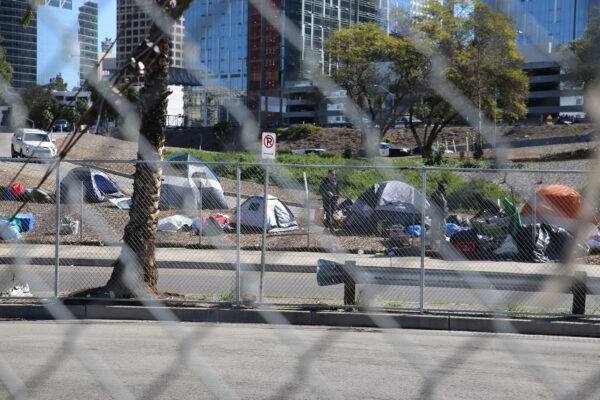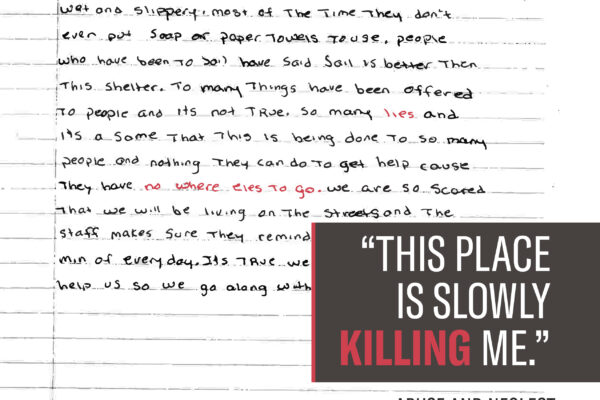After she became homeless, Callie Rutter entered Bridges at Kraemer Place, an emergency shelter that promises to "connect participants to housing as quickly as possible." For her, however, the shelter has been a bridge to nowhere.
The program claims to place residents in a home in six months or less. But Callie has lived at the shelter — a converted warehouse that holds around 200 people — for almost a year, and many of her fellow residents have lived there much longer.
The shelter should not make promises it cannot keep. But it is California's elected officials who have neglected to commit the resources necessary to make the shelter's promise a reality. Their failure to fully fund and develop enough permanent, affordable housing to end the homelessness crisis leaves people like Callie languishing in shelters or on the streets for years and sometimes even decades.
The hard numbers tell it all. In California, there are only 22 subsidized affordable units of housing per 100 extremely low-income households who need them. Because of this shortage, people who are priced out of California's exorbitantly expensive housing market face five to 10 year waits for a permanent, affordable home — that is, if they can get on the waiting lists, which stay closed for years. It is no wonder that California has the largest homeless population in the nation.
Callie should not be living in a shelter. She has been diagnosed with cancer and spends much of her time in chemotherapy and radiation treatments. Her immune system is compromised, and the shelter environment exposes her to contagious diseases. She does her best to manage her side effects, which include incapacitating bouts of nausea and fatigue, while sharing a bathroom and sleeping area with hundreds of people. But the stress of residing in a cramped living space with so many other residents is wearing her down.
"Can I outlive my title of homeless?" she wrote in her journal. "Will I survive cancer? Both are silent killers, but which will kill me first?"
While Callie's situation is extreme, emergency shelters are not appropriate long-term living situations for anyone. Although they can provide protection from the elements and sometimes access to services, research shows that emergency shelters also crowd large numbers of people together, leading to psychological distress, greatly restrict residents' freedom, expose them to infection, deprive them of a private life, and can be very stressful places to live. It is also worth noting that many emergency shelters in California are unlicensed, dangerously unregulated, and, as documented in a recent ACLU of Southern California report, filthy and abusive.
At most, people should stay in shelters for a few days or weeks while they are connected to a permanent, affordable home.
Yet, the state appears to be in danger of veering in a drastically different direction.
The governor has assembled a Task Force charged with crafting recommendations for a state-wide response to homelessness, and the opening gambit from the co-chairs calls on California to establish a “right” to emergency shelter – a recommendation that would entail a massive expansion of the emergency shelter system. This strategy does nothing to address the housing affordability crisis and would condemn people like Callie to years of shelter living. It also upends our national commitment to affordable housing as the primary solution to homelessness, which has been the national best practice since 2003. The ACLU of California stridently opposes this proposal.
To make matters worse, the co-chairs of the Task Force also floated the idea of establishing an "obligation" to accept emergency shelter when it is available — a scheme that would involve clearing people off the streets and confining them in government-funded settings. This policy doesn't end homelessness. Instead, it forcibly warehouses people experiencing homelessness in spaces away from public view.
Facing backlash, the co-chairs have pivoted somewhat from this extreme opening position to advocating for an "invitation" rather than an "obligation" to accept shelter. Still, we remain alarmed that the co-chairs entertained the original proposal at all, and strenuously oppose any plan to force people to live anywhere through sanctions.
The homelessness crisis did not happen overnight. It is the result of decades of disinvestment in subsidized affordable housing at all levels of government, starting with an astounding 80 percent cut in federal funding during the 1980s. Over the subsequent decades, financing for various funding programs that support affordable housing, including the Community Development Block Grant program and the HOME program, have been slashed by over 50 percent. California can and must reverse this trend by making an unwavering commitment to affordable housing and needed services.
That is why the ACLU of California sent a letter to the members of the Task Force telling them that California can no longer afford to tinker around the edges of this catastrophe. The letter urges them to develop a state-wide policy proposal that unequivocally recommends permanent, affordable housing coupled with appropriate services as an immediate response to homelessness and the resources needed to realize this commitment.
Callie suspects that she may never cross that bridge to the home she so desperately needs. But if state policymakers get serious about real solutions, she might just have a fighting chance to escape homelessness.



